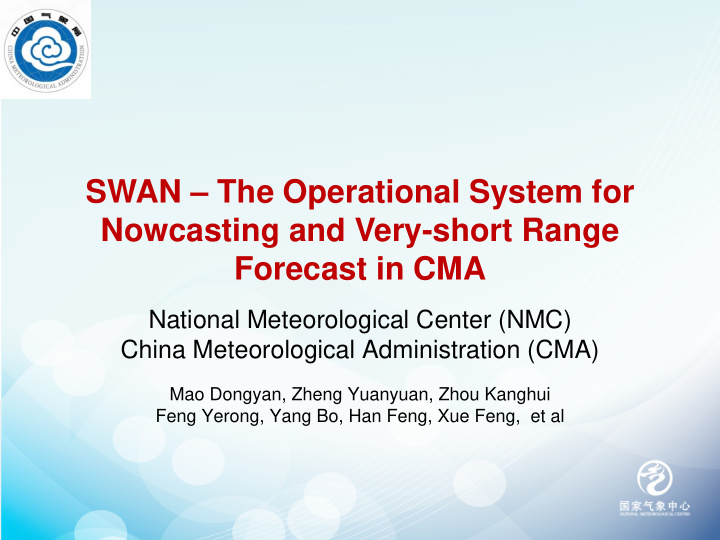



SWAN – The Operational System for Nowcasting and Very-short Range Forecast in CMA National Meteorological Center (NMC) China Meteorological Administration (CMA) Mao Dongyan, Zheng Yuanyuan, Zhou Kanghui Feng Yerong, Yang Bo, Han Feng, Xue Feng, et al
OUTLINE • INTRODUCTION • MAIN FUNCTIONS in SWAN
INTRODUCTION • SWAN - Severe Weather Automatic Nowcasting System • SWAN was developed by the cooperation among NMC, Guangdong Meteorological Bureau, Wuhan Storm Office and other local meteorological departments and research institutions. • SWAN was first proposed in 2008, and updated to V2.0 in June 2016.
SWAN -Severe Weather Auto-Nowcasting Version 0(2009): preliminary finished the framework construction and basic algorithms development Version 1.0(2010): improved the algorithms, embeded the client to Micaps 3.1 Version 1.5(2012): developed the Flash floods integrated platform of geological disasters, upgraded the client to Micaps 3.2 Version 2.0 (2016): integrated new algorithms, updated the client to Micaps4.0
SWAN interface
SWAN DATA FLOW RADAR RADAR UPPER AWS LIGHTNING BASE DATA WARNINGS PUP WARNINGS RADAR 3-D WIND AWS RAINS HAIL IDENTIFICATION QPE SOUNDINGS DATA SOURCE WARNINGS MONITORING FORCAST
MAIN FUNCTIONS in SWAN • Working model • Monitoring and auto-alarm • Nowcasting and very-short range forecast • Warning issuance
Working model • 2 models: real-time model and analyzing model • Real-time model : updated automatically without any operating • Analyzing model : forecasters can operate by using the time-axis and analyzing
Monitoring and auto-alarm Frequency Basic data/technique Products Radar 3-D mosic 6min Radar base data by QC Com. Reflectivity 6min Radar base data by QC 3-DVAR wind 6min Radar base data by QC ET 6min Radar 3-D mosic VIL 6min Radar 3-D mosic 1-h QPE 6min Radar 3-D mosic QPE for heavy rain 1hour Radar 3-D mosic Cotrec wind 6min Radar 3-D mosic AWS 5/10 min AWS observation Lightning Real time Lightning observation AWS warning 5/10 min AWS observation PUP warning PUP products Real time Hail warning 6min Radar 3-D mosic
SWAN2.0 客户端 Radar Monitoring 3DVar Wind RESO=0.02 QPE+COTREC 3-D Ref Mosic
CROSS SECTION C D B A C D A B SET THRESHOLD SET THRESH DISPLAY MORE INFO
AWS Monitoring RAIN : Variation of T and P: RH 、 WIND : Different period different period different threshold from 10min to 24h
TIME-SERIAL 3h Δ P 1h RAIN WIND STATISTIC of a specified area
Auto-Alarm Based on Radar and AWS • Alarm Regions: – Administrative region – Circle (radius defined by user) – user-defined • Alarm Form: – Flash – Sound
ALARM INTERFACE Alarm list Not-read alarm Alarm icon Alarm info
Nowcasting and very-short range forecast Frequency Basic data/technique Products Radar Ref. Fcst 6min Cotrec wind QPF 6min Cotrec wind SCIT 6min Radar 3-D mosic TITAN 6min Radar 3-D mosic
QPF SWAN2.0 客户端 TITAN TI TITA TAN : N : T Thun unde derstorm Iden entification, Tracking, Anal alysis an and d Nowc wcas asting CTRE CTREC C : Current i impl mpleme ementat ation o of Tracking Rada dar Echoe oes by by Correlation on
Radar Echo Nowcasting Radar OBS 1h Radar Ref Nowcasting 11:42 5 Apr,2014
OBJECTIVE Ingredients-Based Methodology FORECAST - Charles Doswell (1996) P = E qw D P: total rainfall E: rainfall efficiency D: duration W: ascending velocity q: mixing ratio for ascending air Charles Doswell The Ingredients-Based Methodology (IM) provides a framework for a systematic assessment of the fundamental physical ingredients that influence the duration, intensity, and type of a given weather phenomenon. (Wetzel and Martin 2001)
Physical Parameters Unstability SI (Showalter Index) LI (Lifting Index) /BLI (Best Lifting Index) T850-T500 (Temperature difference between 850hPa and 500hPa) CAPE (Convective Available Potential Energy) DCAPE (Downdraft CAPE) K (K Index) …… Water Vapour RH (Relative Humidity) PWAT (Precipitable Water) Td (Dew point Temperature) ……
Convergence DIV (Divergence) CON(Convergence) …… Vertical Wind Shear Shr0-6 (0-6km shear) Shr0-3 (0-3km shear) Others T (Temperature) H0 (Height of 0 ℃ ) H20 (Height of -20 ℃ ) WI (Windex) TT (Total Totals) SWEAT (Severe WEAther Threat) ……
Short-Term Heavy Rain Forecast • Short-Term Heavy Rain: PWAT, T850-T500, BLI, RH, Low-level DIV…
Warning issue • 3 ways of warning producing: – Draw warning areas – Select administrative regions – All the area • Warning issued by one button. Draw warning areas Select different areas
THANKS FOR YOUR ATTENTION!
Recommend
More recommend